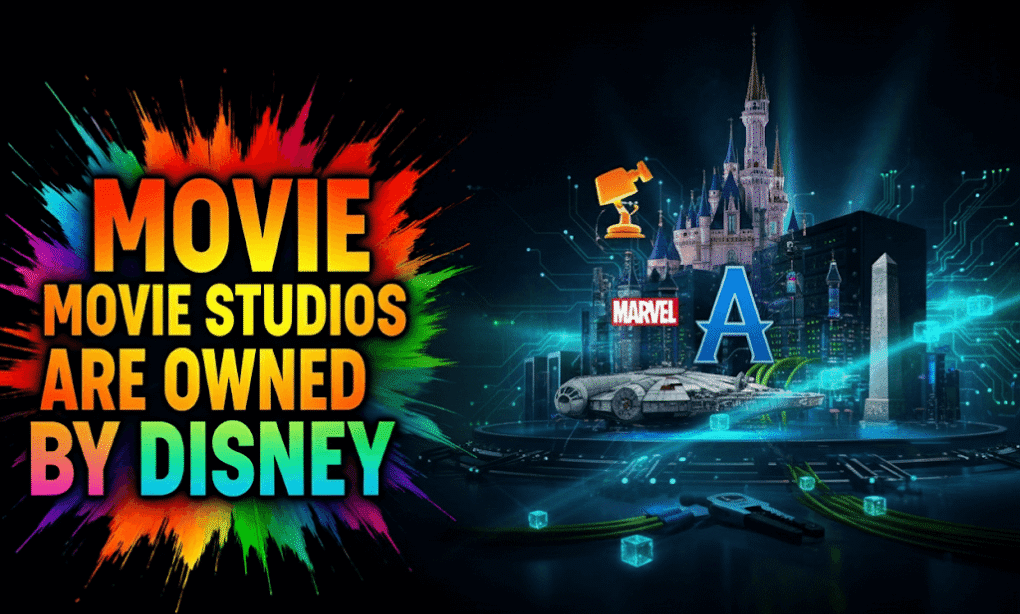The Studios Behind the Magic: What Movie Studios Are Owned by Disney?

Introduction
In the complex, high-stakes world of the entertainment industry, understanding the ownership structure of major media conglomerates isn’t just a matter of trivia—it’s a critical component of strategic planning.
For executives, this knowledge provides a blueprint for competitor analysis, co-production opportunities, and market positioning. When it comes to The Walt Disney Company, its influence extends far beyond the iconic castle logo. The company’s century-long history of expansion has created a vast and often fragmented network of creative powerhouses.
In my analysis, this consolidation presents both immense opportunity and a significant challenge:
how do you get a clear, single view of every project from every studio, at every stage of the supply chain?
This guide will break down exactly what movie studios are owned by Disney and how this interconnected web shapes the global film landscape.
Table of content
Key Takeaways
| Core Challenge | The fragmented nature of the global entertainment supply chain makes it difficult for executives to track a conglomerate’s entire portfolio of projects and partnerships. |
| Strategic Solution | Utilizing a unified market intelligence platform to gain a single, verifiable view of project development, studio activity, and key decision-makers across a vast network of owned companies. |
| Vitrina’s Value Proposition | Vitrina provides real-time, verified data on a wide range of global film and TV projects, helping professionals navigate the complex landscape of a company like Disney and its subsidiaries to identify new opportunities. |
The Strategic Logic Behind Disney’s Acquisitions
To fully grasp Disney’s portfolio, it’s essential to understand the strategic thinking that fueled its major acquisitions. Disney’s approach has been less about simple market consolidation and more about securing control over key intellectual property (IP) and creative talent. This is a form of vertical and horizontal integration that has reshaped the entire industry.
Acquisitions like Pixar, Marvel, and Lucasfilm were not just about buying a brand; they were about gaining ownership of a pipeline of evergreen, high-value franchises. According to research by Statista, the Marvel Cinematic Universe has become the highest-grossing film franchise of all time, demonstrating the immense value of this IP-centric strategy.
By bringing these studios under a single corporate umbrella, Disney can leverage their characters and stories across multiple business segments—from theme parks and merchandise to television series and direct-to-consumer streaming.
The 2019 acquisition of 21st Century Fox, a deal valued at approximately $71.3 billion, was the culmination of this strategy. It provided Disney with a vast film and television library, a global distribution network, and studios like 20th Century and Searchlight, expanding their content offering to appeal to a wider demographic. The result is a media giant with an unparalleled, interconnected ecosystem of storytelling assets.
For an M&E executive, the pain point here is not the consolidation itself, but the lack of transparent, real-time data on how these assets are being deployed. Deals and projects move quickly, and without a centralized source of truth, it’s nearly impossible to track the development status of every new Star Wars show or the financing for the next Pixar film.
The traditional methods of relying on fragmented news reports or personal networks fall short when faced with such a massive and secretive corporate structure. For professionals trying to identify co-production partners, find vendors, or track competitive moves, this opacity is a major obstacle.
What Movie Studios Are Owned by Disney? The Core Portfolio
The Walt Disney Studios is the central division that houses the company’s core film production and distribution assets. While some studios operate with a high degree of creative autonomy, their output and strategic direction are ultimately guided by Disney’s corporate vision. The primary studios within this portfolio are:
Walt Disney Pictures
This is the flagship live-action production arm, responsible for the classic animated-to-live-action remakes, family-friendly adventures, and big-budget spectacle films that define the “Disney brand” for many. Its output includes franchises like Pirates of the Caribbean and the recent string of blockbuster adaptations like The Lion King and Aladdin.
Walt Disney Animation Studios
The original animation studio that started it all. From Snow White to Frozen, this studio is the creative heart of Disney’s legacy. It is the birthplace of the Disney Princess franchise and a powerhouse of innovation that continues to set the standard for hand-drawn and computer-generated animation.
Pixar Animation Studios
Acquired in 2006 for $7.4 billion, Pixar is known for its emotionally resonant, groundbreaking CG-animated films such as Toy Story, Finding Nemo, and Inside Out. The acquisition brought not only immense creative talent but also a new pipeline of intellectual property that has become a core part of Disney’s content library.
Marvel Studios
Arguably Disney’s most successful acquisition to date, Marvel Studios was purchased in 2009 for $4 billion. This deal gave Disney ownership of thousands of characters and the rights to the Marvel Cinematic Universe (MCU), which has dominated the global box office for over a decade. The studio’s output includes the Avengers films, along with countless sequels and Disney+ series, creating a self-sustaining content engine. According to The Numbers, Marvel Studios has generated tens of billions of dollars in global box office revenue since the acquisition.
Lucasfilm
Home to the monumental Star Wars and Indiana Jones franchises, Lucasfilm was acquired for $4.05 billion in 2012. Like the Marvel deal, this was a strategic move to acquire a pre-existing, beloved universe with immense merchandising and storytelling potential. Under Disney’s ownership, Lucasfilm has expanded its narrative universe through new films, series, and animated content on Disney+.
20th Century Studios and Searchlight Pictures
As part of the 2019 acquisition of 21st Century Fox, Disney gained control of these two prominent studios. 20th Century Studios (formerly 20th Century Fox) is a historic major studio responsible for iconic franchises like Avatar and the X-Men series.
Searchlight Pictures (formerly Fox Searchlight) is a specialty film studio known for producing critically acclaimed, independent, and arthouse content, including multiple Best Picture Oscar winners like Nomadland and The Shape of Water. This duality allows Disney to target both mass-market audiences and niche, awards-focused markets simultaneously.
Integrating the Creative Portfolio: The Challenge of Visibility
While Disney’s strategic acquisitions have been a masterclass in IP consolidation, they have created a complex ecosystem that is challenging to navigate for outsiders. For an executive responsible for scouting talent, identifying emerging projects, or monitoring a competitor’s strategic moves, the sheer volume and velocity of content from these studios can be overwhelming.
Each studio operates with its own development slate, production partners, and a network of producers, directors, and writers. This decentralized activity is often not made public until a late stage, leaving competitors and partners in the dark. The problem is a lack of a single, verifiable data source that connects all the dots.
Traditional industry resources fail to provide the granularity needed. Trade publications offer snapshots, but not a holistic, real-time feed of every project from development to release. Manual research is inefficient and incomplete.
As a result, valuable time is lost, and potential opportunities for co-production, co-financing, or service provision are missed. Consider a scenario where an independent animation studio wants to pitch a project to Disney.
Without a tool to track the specific animation projects currently in development at Walt Disney Animation, Pixar, and even 20th Century Studios, their outreach is a shot in the dark. The same applies to a VFX studio trying to identify which of the hundreds of upcoming Marvel or Lucasfilm projects need their services.
The Future of Disney’s Studio Empire
Looking ahead, the role of Disney’s owned studios will continue to evolve, particularly in a world driven by streaming. The strategic focus is on feeding the content machine of Disney+ and Hulu while maintaining a strong theatrical presence for tentpole franchises.
This has led to a more centralized and coordinated approach to content creation, where executives at the highest level—like Alan Bergman, Co-Chairman of Disney Entertainment—oversee the full portfolio of studios to ensure they align with the company’s broader corporate strategy.
The acquisitions of Marvel, Lucasfilm, and Fox were all about building a content moat against emerging competitors like Netflix and Amazon, and that strategy remains paramount. Future moves will likely focus on strengthening this moat, either through new partnerships, talent acquisitions, or an even deeper integration of their existing IP.
The key for industry professionals will be to find a way to track these shifts, identifying new opportunities as they arise, whether for co-financing, distribution, or providing vital services.
How Vitrina Helps Track Disney’s Studio Empire
For an executive, the sheer scale of Disney’s operations is both a challenge and an opportunity. Vitrina’s platform is designed to transform this challenge into a strategic advantage. It provides a unique, data-centric lens into the activities of all of Disney’s owned studios by:
- Tracking Projects in Development: Vitrina’s Film & TV Projects Tracker offers real-time updates on thousands of global projects, including those from Disney and its subsidiaries. This means you can track a new Lucasfilm project from a concept announcement to a greenlight, months before it hits the production phase.
- Mapping the Supply Chain: The platform links projects to the companies and professionals involved. You can see who is producing a new 20th Century Studios film, which VFX house is handling the effects, and which executives are attached to the project. This level of detail is impossible to find in a single, reliable source anywhere else.
- Connecting the Dots: By cross-referencing data points, Vitrina identifies collaboration patterns and strategic relationships. A distribution executive can find which studios are co-producing films with Searchlight Pictures, or a financier can identify which independent production companies are frequently tapped by Walt Disney Pictures.
Conclusion
The question “what movie studios are owned by Disney?” reveals a far more complex picture than a simple list of names. It speaks to a century-long strategy of vertical integration and the consolidation of creative power.
From the legendary animations of Walt Disney Animation to the superhero epics of Marvel and the awards-season darlings of Searchlight, Disney’s empire is a testament to its market dominance. For M&E professionals, this landscape presents a clear challenge: gaining comprehensive, actionable insight into the operations of such a vast network.
By leveraging a platform like Vitrina, you can move beyond fragmented data and gain the strategic clarity required to identify opportunities, forge partnerships, and thrive in this interconnected ecosystem. Don’t get lost in the noise of the M&E industry—let the right data guide you.
Start making smarter, faster, and more informed decisions today with a platform built for professionals like you.
Sign-up today and revolutionize your market intelligence.To start your journey, Sign-up Today
Frequently Asked Questions
The Walt Disney Studios is the primary film division of The Walt Disney Company. It is the corporate umbrella for all of Disney’s film production and distribution assets, including the most prominent studios like Walt Disney Pictures, Marvel Studios, Pixar, and Lucasfilm.
Answer Disney’s major studio acquisitions include Pixar for $7.4 billion in 2006, Marvel for $4 billion in 2009, Lucasfilm for $4.05 billion in 2012, and the acquisition of 21st Century Fox for approximately $71.3 billion in 2019.
Yes, Disney launched Touchstone Pictures in the 1980s to produce content for more mature audiences. While the studio is still owned by Disney, it has been largely dormant for several years and is no longer an active film production label.
Walt Disney Pictures is the main live-action studio, responsible for films like Pirates of the Caribbean and live-action remakes. Walt Disney Animation Studios is the dedicated animation studio that produces the classic Disney animated films such as Frozen and The Little Mermaid.

























